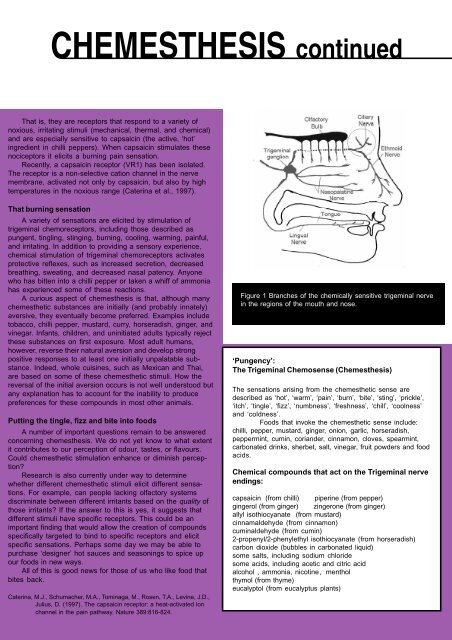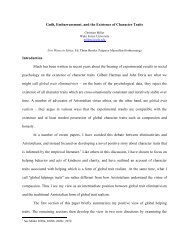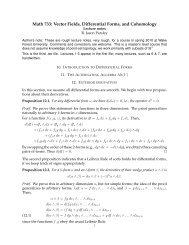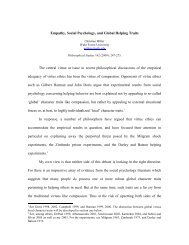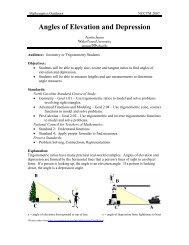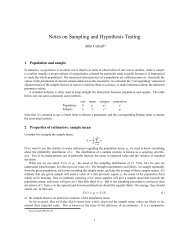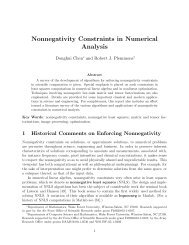The burning questions - Wake Forest University
The burning questions - Wake Forest University
The burning questions - Wake Forest University
Create successful ePaper yourself
Turn your PDF publications into a flip-book with our unique Google optimized e-Paper software.
2<br />
CHEMESTHESIS continued<br />
That is, they are receptors that respond to a variety of<br />
noxious, irritating stimuli (mechanical, thermal, and chemical)<br />
and are especially sensitive to capsaicin (the active, ‘hot’<br />
ingredient in chilli peppers). When capsaicin stimulates these<br />
nociceptors it elicits a <strong>burning</strong> pain sensation.<br />
Recently, a capsaicin receptor (VR1) has been isolated.<br />
<strong>The</strong> receptor is a non-selective cation channel in the nerve<br />
membrane, activated not only by capsaicin, but also by high<br />
temperatures in the noxious range (Caterina et al., 1997).<br />
That <strong>burning</strong> sensation<br />
A variety of sensations are elicited by stimulation of<br />
trigeminal chemoreceptors, including those described as<br />
pungent, tingling, stinging, <strong>burning</strong>, cooling, warming, painful,<br />
and irritating. In addition to providing a sensory experience,<br />
chemical stimulation of trigeminal chemoreceptors activates<br />
protective reflexes, such as increased secretion, decreased<br />
breathing, sweating, and decreased nasal patency. Anyone<br />
who has bitten into a chilli pepper or taken a whiff of ammonia<br />
has experienced some of these reactions.<br />
A curious aspect of chemesthesis is that, although many<br />
chemesthetic substances are initially (and probably innately)<br />
aversive, they eventually become preferred. Examples include<br />
tobacco, chilli pepper, mustard, curry, horseradish, ginger, and<br />
vinegar. Infants, children, and uninitiated adults typically reject<br />
these substances on first exposure. Most adult humans,<br />
however, reverse their natural aversion and develop strong<br />
positive responses to at least one initially unpalatable substance.<br />
Indeed, whole cuisines, such as Mexican and Thai,<br />
are based on some of these chemesthetic stimuli. How the<br />
reversal of the initial aversion occurs is not well understood but<br />
any explanation has to account for the inability to produce<br />
preferences for these compounds in most other animals.<br />
Putting the tingle, fizz and bite into foods<br />
A number of important <strong>questions</strong> remain to be answered<br />
concerning chemesthesis. We do not yet know to what extent<br />
it contributes to our perception of odour, tastes, or flavours.<br />
Could chemesthetic stimulation enhance or diminish perception?<br />
Research is also currently under way to determine<br />
whether different chemesthetic stimuli elicit different sensations.<br />
For example, can people lacking olfactory systems<br />
discriminate between different irritants based on the quality of<br />
those irritants? If the answer to this is yes, it suggests that<br />
different stimuli have specific receptors. This could be an<br />
important finding that would allow the creation of compounds<br />
specifically targeted to bind to specific receptors and elicit<br />
specific sensations. Perhaps some day we may be able to<br />
purchase ‘designer’ hot sauces and seasonings to spice up<br />
our foods in new ways.<br />
All of this is good news for those of us who like food that<br />
bites back.<br />
Caterina, M.J., Schumacher, M.A., Tominaga, M., Rosen, T.A., Levine, J.D.,<br />
Julius, D. (1997). <strong>The</strong> capsaicin receptor: a heat-activated ion<br />
channel in the pain pathway. Nature 389:816-824.<br />
Figure 1 Branches of the chemically sensitive trigeminal nerve<br />
in the regions of the mouth and nose.<br />
Figure 1<br />
‘Pungency’:<br />
<strong>The</strong> Trigeminal Chemosense (Chemesthesis)<br />
<strong>The</strong> sensations arising from the chemesthetic sense are<br />
described as ‘hot’, ‘warm’, ‘pain’, ‘burn’, ‘bite’, ‘sting’, ‘prickle’,<br />
‘itch’, ‘tingle’, ‘fizz’, ‘numbness’, ‘freshness’, ‘chill’, ‘coolness’<br />
and ‘coldness’.<br />
Foods that invoke the chemesthetic sense include:<br />
chilli, pepper, mustard, ginger, onion, garlic, horseradish,<br />
peppermint, cumin, coriander, cinnamon, cloves, spearmint,<br />
carbonated drinks, sherbet, salt, vinegar, fruit powders and food<br />
acids.<br />
Chemical compounds that act on the Trigeminal nerve<br />
endings:<br />
capsaicin (from chilli) piperine (from pepper)<br />
gingerol (from ginger) zingerone (from ginger)<br />
allyl isothiocyanate (from mustard)<br />
cinnamaldehyde (from cinnamon)<br />
cuminaldehyde (from cumin)<br />
2-propenyl/2-phenylethyl isothiocyanate (from horseradish)<br />
carbon dioxide (bubbles in carbonated liquid)<br />
some salts, including sodium chloride<br />
some acids, including acetic and citric acid<br />
alcohol , ammonia, nicotine, menthol<br />
thymol (from thyme)<br />
eucalyptol (from eucalyptus plants)


